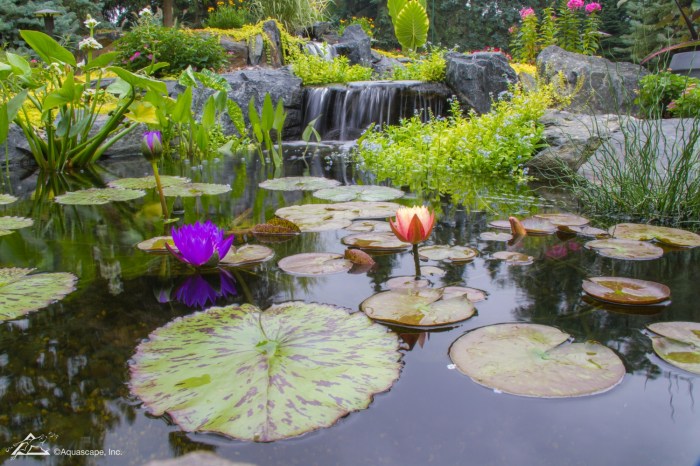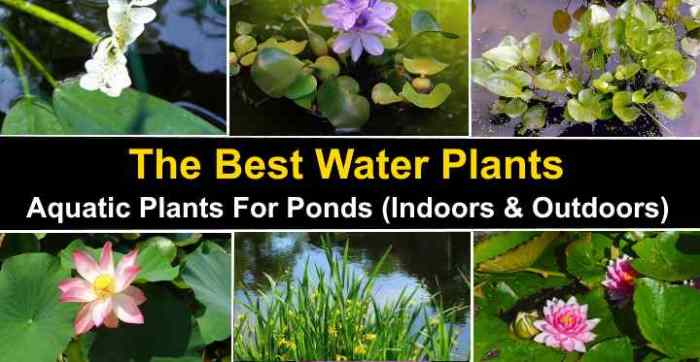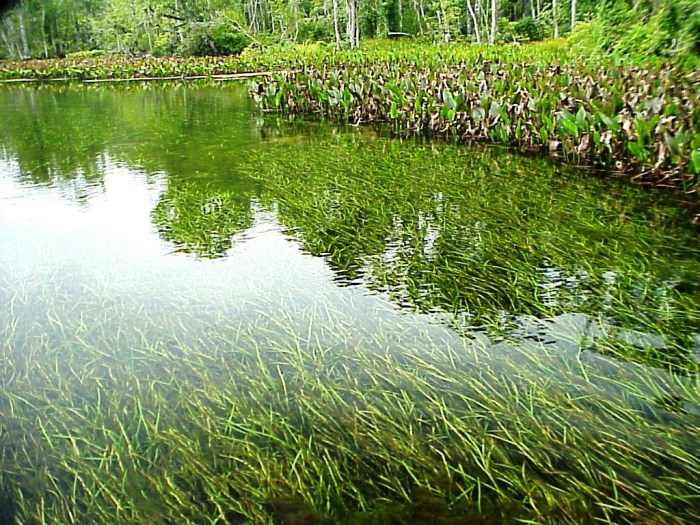What Plants Can Live in Water?
Hydroponics and Aquatic Plants: A Comprehensive Guide
What plants can live in water – Growing plants in water, whether through hydroponics or direct submersion, offers a unique and rewarding experience. This guide delves into the nuances of cultivating aquatic plants, covering everything from basic principles to advanced techniques. We’ll explore the differences between hydroponic systems and simple water-based cultivation, essential nutrient requirements, and practical tips for success.
Hydroponics versus Direct Water Cultivation
While both hydroponics and growing plants directly in water involve cultivating plants without soil, they differ significantly. Hydroponics utilizes a nutrient-rich solution delivered directly to the plant roots, often with inert media for support. Direct water cultivation, on the other hand, involves placing plants directly into water, relying on the water itself to supply nutrients. Hydroponics generally offers more control over nutrient delivery and allows for faster growth, while direct water cultivation is simpler to set up and maintain, suitable for less demanding plant species.
Essential Nutrients for Aquatic Plant Growth
Aquatic plants, like all plants, require essential macronutrients (nitrogen, phosphorus, potassium) and micronutrients (iron, manganese, zinc, etc.). The specific requirements vary depending on the species. Nitrogen is crucial for leaf growth, phosphorus for root development and flowering, and potassium for overall plant health and disease resistance. Micronutrients play vital roles in various metabolic processes. Nutrient deficiencies manifest as yellowing leaves, stunted growth, or other abnormalities.
Common Misconceptions about Growing Plants in Water
Several misconceptions surround growing plants in water. Many believe that any plant can thrive in water, which is false. Another common misconception is that tap water is sufficient, neglecting the importance of pH and nutrient levels. Finally, some believe that water-grown plants are inherently weaker, but with proper care, they can be just as robust as soil-grown plants.
Types of Aquatic Plants
A wide variety of plants thrive in aquatic environments, each with unique characteristics and care requirements. Selecting appropriate plants based on light needs and care complexity is crucial for success.
| Plant Name | Scientific Name | Light Requirements | Care Difficulty |
|---|---|---|---|
| Water Hyacinth | Eichhornia crassipes | High | Easy |
| Duckweed | Lemna minor | Medium | Easy |
| Water Lettuce | Pistia stratiotes | High | Easy |
| Anacharis | Elodea canadensis | Medium | Easy |
| Java Fern | Microsorum pteropus | Low to Medium | Easy |
| Amazon Sword Plant | Echinodorus amazonicus | High | Medium |
| Cryptocoryne | Cryptocoryne spp. | Low to Medium | Medium |
| Hornwort | Ceratophyllum demersum | Medium | Easy |
| Water Sprite | Ceratopteris thalictroides | Medium to High | Easy |
| Red Ludwigia | Ludwigia repens ‘Rubin’ | High | Medium |
Duckweed and Anacharis are excellent choices for beginners due to their resilience and ease of care. Water hyacinth, while beautiful, can grow rapidly and may require more frequent trimming.
Care Requirements for Different Aquatic Plant Types
Submerged plants, like Anacharis, remain entirely underwater. Floating plants, such as Water Lettuce, float on the surface. Emergent plants, such as the Amazon Sword Plant, have roots submerged but leaves extending above the waterline. Submerged plants generally require brighter light and good water circulation. Floating plants can tolerate a wider range of conditions but can become invasive if not managed.
Emergent plants need sufficient depth for their roots and may need more nutrients.
Water Quality and Maintenance
Maintaining optimal water quality is paramount for healthy aquatic plant growth. This involves monitoring pH levels, ensuring sufficient oxygenation, and regularly changing the water.
Importance of Water pH
The pH level of the water significantly impacts nutrient availability and plant health. Most aquatic plants prefer a slightly acidic to neutral pH range (6.0-7.5). Extreme pH levels can lead to nutrient deficiencies or toxicity, affecting growth and overall plant health. Regular monitoring with a pH meter is recommended.
Maintaining Optimal Water Conditions
Regular partial water changes (25-50% weekly) help remove accumulated waste products and replenish essential nutrients. Adequate aeration, either through air pumps or by ensuring good water circulation, is crucial for oxygen supply to the roots. Avoid using tap water directly; let it sit for 24 hours to allow chlorine to dissipate or use filtered water.
Common Water Quality Issues and Solutions

Source: aquascapes.com
Cloudy water often indicates excessive algae growth or decaying organic matter. Solutions include increased water changes, improved filtration, or reducing light intensity. A foul odor suggests bacterial contamination, requiring thorough cleaning and potentially a complete water change. Nutrient deficiencies can be addressed by using appropriate aquatic plant fertilizers.
Container Selection and Setup

Source: leafyplace.com
Choosing the right container and preparing it correctly are crucial steps in establishing a successful aquatic plant environment. The container’s size, material, and transparency all influence plant growth and overall aesthetics.
Container Types and Suitability
Glass jars and vases are suitable for smaller plants and offer clear visibility. Specialized hydroponic systems provide greater control over nutrient delivery and water circulation, ideal for larger or more demanding plants. The choice depends on the plant type, available space, and desired level of control.
Many plants thrive in aquatic environments, from water lilies to various types of aquatic grasses. However, the water requirements vary greatly depending on the species. For instance, understanding how much water a jade plant needs is crucial for its health; you can find helpful advice on this at how much water should a jade plant get.
Conversely, overwatering a plant adapted to drier conditions can be just as detrimental as underwatering a water-loving plant.
Preparing Containers for Aquatic Plants
Thoroughly clean the container with soap and water to remove any residue. Rinse thoroughly to eliminate any soap traces. For hydroponic systems, follow the manufacturer’s instructions for setup and priming. For direct water cultivation, ensure the container is stable and large enough to accommodate the plant’s root system and growth.
Preventing Algae Growth
Algae growth can be controlled by maintaining good water quality, avoiding excessive light exposure, and using algae-eating snails or fish (if applicable). Regular partial water changes and cleaning of the container are crucial in minimizing algae proliferation. Introducing aquatic plants that compete with algae for nutrients can also help to control its growth.
Propagation and Growth Techniques
Propagating aquatic plants is often straightforward, employing various methods to increase your collection. Monitoring plant growth and making necessary adjustments ensures optimal health and development.
Methods for Propagating Aquatic Plants
Many aquatic plants can be propagated easily through stem cuttings. Simply cut a healthy stem and place it in water; roots will develop within a few weeks. Some plants, like Java Fern, can be propagated by separating off plantlets or runners. Seed propagation is less common but possible for certain species.
Planting Aquatic Plants in Water Containers
Carefully place the plant in the container, ensuring the roots are submerged but the leaves are above the waterline (for emergent plants). Avoid overcrowding the container, allowing adequate space for growth. For hydroponic systems, follow the specific instructions for planting media and nutrient solution.
Monitoring Plant Growth and Adjusting Care
Regularly observe the plants for signs of stress, nutrient deficiencies, or disease. Adjust lighting, fertilization, and water changes as needed based on plant growth and water quality. Pruning may be necessary to control growth and maintain aesthetic appeal.
Troubleshooting Common Problems: What Plants Can Live In Water
Several issues can arise when growing plants in water. Early identification and appropriate solutions are crucial for preventing serious damage.
Common Problems and Solutions
Root rot is a common problem caused by poor water quality or insufficient oxygen. Solutions include improving water circulation, reducing organic matter, and using a fungicide if necessary. Nutrient deficiencies manifest as yellowing or discolored leaves; address these by using appropriate fertilizers. Pest infestations can be controlled with natural methods or appropriate pesticides.
Preventative Measures, What plants can live in water
- Regular water changes
- Proper aeration
- Balanced nutrient levels
- Regular inspection for pests and diseases
- Avoid overcrowding plants
Advanced Techniques and Considerations
For more advanced cultivation, exploring specialized nutrients and different hydroponic systems can significantly enhance plant growth and presentation.
Specialized Nutrients and Fertilizers
Specialized aquatic plant fertilizers provide tailored nutrient ratios to optimize plant growth. These fertilizers often contain chelated micronutrients, ensuring better absorption by the plants. The choice of fertilizer depends on the specific plant species and their nutrient requirements.
Hydroponic Systems for Aquatic Plants

Source: ufl.edu
Deep water culture (DWC) systems provide excellent oxygenation and nutrient delivery. Nutrient film technique (NFT) systems continuously flow nutrient solution over the roots. The choice of system depends on the scale of cultivation and desired level of control.
Creative Displays and Arrangements
Aquatic plants can be used to create stunning displays and arrangements in various containers and settings. Combining different plant species with varying textures, colors, and heights can create visually appealing and dynamic aquatic gardens. Consider using creative containers, such as repurposed glass bottles or unique ceramic vessels, to add a personal touch.
Essential Questionnaire
Can I use tap water for aquatic plants?
It’s best to let tap water sit out for 24 hours to allow chlorine and chloramine to dissipate. Using filtered or distilled water is ideal.
How often should I change the water?
Frequency depends on the plant and container size. Small containers may need weekly changes; larger ones, less frequently. Aim for clean, clear water.
What are the signs of nutrient deficiency in aquatic plants?
Signs include stunted growth, yellowing leaves, and overall lack of vigor. Supplementing with aquatic plant fertilizer can address this.
How do I prevent algae growth?
Regular water changes, proper lighting, and avoiding over-fertilizing help control algae. Consider using a UV sterilizer for larger setups.




















